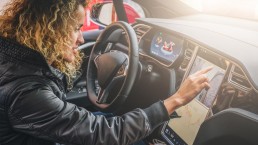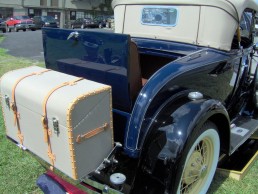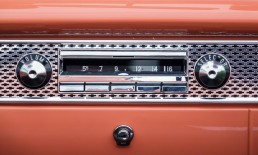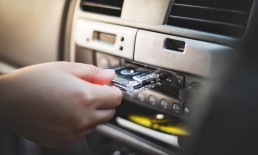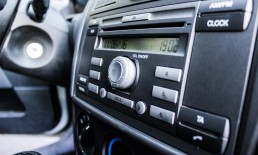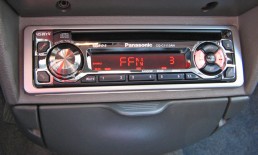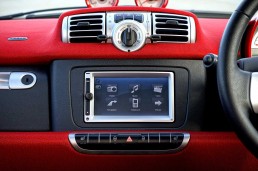Forget the concept of cars being smartphones on wheels. Vehicles are rapidly headed toward whole “living rooms on wheels.”
Traffic updates, maps, music, movies, games, apps – these are some of the services that are already available in the in-vehicle infotainment (IVI) systems of today. But the dream car of the future will have all of this and more meaningful experiences too – like VR entertainment or fine dining.
But how do we craft those experiences? Well, it requires a helluva lot of data served up by the IVI. And whenever you have data, you also need a way to manage and store it.
The development toward data-driven IVI has been many decades in the making. Did you know that Tuxera – one of the 20 Coolest Data Management Companies – is also a part of this history? We thought it would be fun to travel back through time and see how data, storage, and car infotainment have been entwined over the years. Read on for a rundown of how this triad has evolved – and how Tuxera’s data management software grew to be a part of that story.
We’ll start off where the IVI begins – the radio!
Pre-1940s: The radio star, IVI’s early ancestor
The earliest ancestor of the IVI was the car radio, which has roots all the way back to Chevrolet in 1922! That first model was unfeasibly bulky and extremely expensive, however. Thus, we had to wait until the 1930s for the radio to become a notable part of the dashboard.
Back then, the only “data” to speak of was transmitted as music and voice carried by radio waves, and storage space strictly meant the physical space for storage – the car’s trunk.
1940s and 50s: Radio pre-sets as mechanical “data” storage
Throughout the 40s and 50s, car radios acquired physical buttons to remember your favorite radio stations. To “program” your favorite stations or “preset” them, you would activate one of the buttons, tune the radio dial to the radio frequency you like, then push in the button to “remember” the station. Every time you again pressed that button, the radio tuner would jump straight to that favorite frequency or yours. This feature represents the first way to store data – in the form of station presets – within the car, albeit through mechanical means.
I have to stop this piece for one brief moment and give MUCH RESPECT to Dr. Peter Goldmark, former Head of CBS Laboratories, who actually got a vinyl record player working inside a car in the 1950s. This led to a brief appearance of the in-car record players during that decade. Incidentally, if you own a Chrysler with one of these babies, I will definitely hit you up for a ride sometime and bring my own 45-single to play!
1960s – 1980s: The cassette tape and analog data storage era
The 60s gave rise to the first widely adopted form of external analog data storage for cars – the eight-track cassette. Magnetic tape had already been in use for a few decades to store and playback audio data (also known as music). In simplest terms, data – or audio signals in this case – is stored on magnetic tape through magnetic manipulation of the tape’s oxide layer, which can be later turned into an electronic signal during playback by a tape head – and finally played through the car speakers.
Eight-tracks were large and cumbersome, however, which led to the dominance of compact cassette players in cars throughout the 70s and 80s.
What’s more, on-board navigation entered the Japanese consumer scene in 1981 through the Electro Gyro-Cator – a system developed in cooperation between Honda, Alpine, and Stanley Electric. The Electro Gyro-Cator did not use GPS satellites for navigation, rather it was an inertial navigation system with a built-in gyroscope. It had transparent map films that were illuminated on a screen and scrolled around as the car moved. That said, automotive navigation technology was very expensive (in the Electro Gyro-Cator’s case it cost a quarter of the car’s total value!), and thus took a couple decades to be simplified and integrated into consumer cars.
1990s: CD was king and digital data gained a foothold
By the 90s, digital data made its way into cars on compact discs (CDs). CD-players became an integrated part of the car, or at very least one of the most highly prized after-market additions. That’s because the CD was very light and portable, so it became very easy to take your music everywhere.
CDs are made to store data along a track by etching microscopic “pits” along the surface, and gaps in between the pits. As the CD spins, a finely tuned laser is beamed over the surface, reflecting light back at a reading sensor.
The reflected light changes depending on whether the laser is hitting a gap or a pit, thus forming the familiar 0s and 1s of the binary data-system.
Even though CDs were small and light, they still required physical space to store in cars. As an aside: they were often a target of car thieves as well, if you had any sign that your car could be carrying a treasure trove of CDs.
In addition to the CD player, GPS navigation and backup cameras were popular after-market accessories that became fundamental components – setting the foundation for the IVI as we know it today. The end of this era also brought the first head units that played MP3s, while high-end autos shipped with DVD players.
2000s: IVI as we know it was born with Generation Z!
The first true IVI systems as we might recognize them emerged in the early 2000s. These early head units had touchscreens to play your music, and served up GPS navigation assistance. The interfaces were simple – often created in-house by the suppliers responsible for building and integrating the IVI.
The first hard drives also shipped inside cars to store data needed for navigation or other data needed by the IVI.
By 2006, USB slots made their appearance in cars, which could be used to transfer data, music, videos, or maps from USB flash drives to the IVI. Bluetooth connectivity also came into demand to allow you to take calls, and eventually for streaming music from your smartphone.
These two monumental feature developments for IVI – portable data connectivity and Bluetooth – allowed you as the driver to bring whatever data or media you wanted into your vehicle.
Another landmark moment in the history of IVI during this decade was the formation of the GENIVI Alliance in 2009. The alliance was a cooperative effort by many of the large carmakers, suppliers, chipset makers, and automotive electronics vendors. This cooperation was originally aimed at driving the widespread adoption of an open-source development platform for IVI. The ultimate dream of such a collective would be to effortlessly and seamlessly deliver a plethora of services and entertainment to your vehicles – no matter what type of car you drive.
2010s: The “bring your own data” years peak
By 2010, USB and also SD card ports were already commonplace in most major car brands. Media and data were brought into the car on these forms of portable flash media. At the same time, IVIs were also getting more complex. The IVI did a lot more things for you on top of music playback – running basic entertainment apps, navigation, indoor climate controls, and facilitating handsfree phone use. To do all these neat new things, the IVI needed built-in, embedded flash media (such as eMMC) to support internal storage of the IVI’s operating system, the built-in app storage, and map data.
Some IVIs had two different built-in storage media: an embedded storage chip like eMMC, and an embedded SD card (which could only be removed by a service professional) to store data like maps. And remember, because this was the age of portable data, the IVI also needed to support data transfer between the IVI system and the portable storage.
Especially in the early years of this decade, USB sticks and SD cards were mostly formatted with the FAT file system. The problem with FAT is that you could only store files up to 4 GB in size, and as digital media became more prevalent and of higher quality, file sizes continued to grow. While that’s not an issue for most music files, it started becoming a problem very quickly for map file size. Not to mention, many people wanted to use the same USB sticks or SD cards in their home computers, their set-top boxes and TVs, and bring them back into the car – so they were storing not only music, but also large video files on these same removable storages. The NTFS file system and later exFAT could support these larger files, so the IVIs had to have internal software to support more file systems beyond FAT.
This is also the age where various storage-related problems started to show up inside your cars – a laggy or unresponsive interface when you searched through your music files, slow IVI boot up time when you started your car, corrupt or missing music and map files, bricked USB and SD cards, or worse – the IVI no longer booted.
Now enter our hidden hero – data storage management software – to handle and manage all these new IVI data needs and storage problems! In 2010, Tuxera’s file systems became available in selected IVIs. Back then, our solutions focused on making it easy to plug in your SD cards and USB sticks into the car’s entertainment system, and for data (such as music) to transfer freely between the storage devices and the car. We call this “interoperability.”
Since then, Tuxera’s interoperable file system implementations – Microsoft exFAT by Tuxera, Microsoft FAT by Tuxera, Tuxera HFS+, and Microsoft NTFS by Tuxera – have been built in to the IVI systems of over 150 million cars, covering all the major car makers around the globe. These file systems are working behind the scenes to make sure your music and media are always there when you want them, and your IVI interface feels fast and smooth even years later, helping you get the best out of your ride. What’s more, Tuxera’s own embedded file system, Reliance Nitro, and flash management software, FlashFX Tera, also began shipping in car infotainment systems to improve boot time and solve issues with degrading lifetime of IVI flash storage.
HANDPICKED RELATED CONTENT
Read how we’ve helped some of our IVI supplier customers with their storage needs: Alpine, Desay, e.solutions, and Yura.
2020s and beyond: Proceed with caution – more IVI data challenges ahead
Skipping ahead to the present and toward the future – the connected car must reliably handle, store, and process data from a variety of sources. Built-in apps stream real-time traffic data, music, and high-quality video. 3D navigation is gaining momentum, over-the-air updates bring new services and software features, in-vehicle stores are gaining traction, and a variety of sensors record data about the car and its surroundings.
All these applications running at once place heavy demands on the car’s flash-based storage. And at the same time the car is increasingly transforming into a very sophisticated supercomputer on wheels, processing massive amounts of data. The architecture inside the connected car is moving away from myriads of control units separately controlling each system, and instead toward centralized control units with shared internal storage housing all the needed data.
HANDPICKED RELATED CONTENT
Want to know more about the automotive storage challenges that lay ahead as the need for data-driven applications grow? Check out our whitepaper: Challenges of Tomorrow’s Data Storage Integrity in Automotive and IOT Projects.
Final thoughts
Automakers and consumers expect that these internal systems will last for the lifetime of the car, from 10 to 20 years. Unfortunately, these expectations are offset by the lifetime of flash memory, which is limited by the number of data write cycles. The inherent way that flash memory works requires erasing and rewriting significantly more memory blocks than is actually needed to write the new data. This unfortunate but expected wear-out of flash storage media is something we’re helping car makers and automotive suppliers tackle.
That’s why we have IVI embedded storage software that offers flash performance and lifetime optimizations including faster and more efficient data management operations. We also have very strong partnerships with leading automotive flash vendors, chipset makers, and software companies, which makes it possible for us to continually improve these optimizations. Automotive infotainment systems powered by our software are better equipped to keep up with consumer expectations: more apps, more sensors assisting the drive, and more streaming data – more of the things to make your ride a bit more fun.
Car makers and Tier-1 suppliers – find out how our data storage software makes automotive infotainment systems faster, more responsive, and more durable.
References
Many thanks for these articles that helped greatly in developing this article:
- A short history of the car radio: https://blog.nationwide.com/car-radio-history/
- Driving content into vehicles: https://www.ibc.org/trends/driving-content-into-vehicles/5363.article
- History of obsolete car audio, part 2: Record players: https://www.hagerty.com/media/automotive-history/obsolete-car-audio-part-2/
- A brief history of the car radio: https://www.lifewire.com/brief-history-of-the-car-radio-534718
- How did the mechanism of preset stations in old car radios work?: https://www.quora.com/How-did-the-mechanism-of-preset-stations-in-old-car-radios-work
- Wikipedia, Magnetic tape: https://en.wikipedia.org/wiki/Magnetic_tape
- Wikipedia, Tape head: https://en.wikipedia.org/wiki/Tape_head
- Wikipedia, Electro Gyro-cator: https://en.wikipedia.org/wiki/Electro_Gyrocator
- How CDs Work: https://electronics.howstuffworks.com/cd.htm
- A history of the car head unit: http://www.techradar.com/us/news/car-tech/a-history-of-the-car-head-unit-1305931
- EXCLUSIVE: First car ever with a built in USB port?: https://www.autospies.com/news/EXCLUSIVE-First-car-ever-with-a-built-in-USB-port-5047/
- Data centers on wheels: https://semiengineering.com/data-centers-on-wheels/
[UPDATE: This article was originally posted in 2016 and updated with new info in 2021.]


